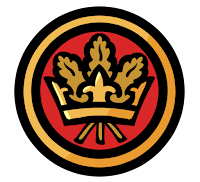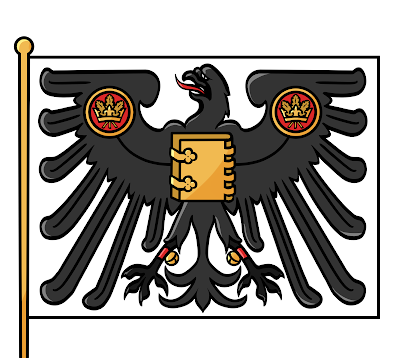.jpg) |
Rudyard Kipling (1865-1936).
Image source: Wikipedia. |
The English novelist and poet Rudyard Kipling (1865-1936) might seem an unlikely source of inspiration for the American herald Pierre de Chaignon la Rose (1872-1941), and I would have believed so until I happened upon Scott-Giles (1970) article revealing a heraldic side of the well-known author. More importantly, Scott-Giles' (1970) article illustrated a coat of arms containing a bordure with eight charges, and this image immediately brought to mind a design by la Rose created two years following Kipling's article.
As I considered the possibility of the English writer's influence on la Rose, I began connecting several data points which utterly shocked me. Both were writers, for beginners. La Rose taught English for several years at Harvard and published a book on the American-British writer Henry James (1843-1916), a colleague in the same category of Kipling (La Rose, 1921). While I have no information regarding la Rose's appreciation of Kipling, the probability most certainly exists as well as the likely impact World War I had on both.
While the "war to end all wars" raged across the European continent, Kipling published an article in The Spectator on November 3, 1917, using the style and language from the 17th Century heraldic writer John Guillim (c.1565-1621). Appropriately titled, "A Displaie of New Heraldrie," Kipling furthered his reference by playing upon the name of Gillim's masterpiece, "A Display of Heraldry" (Kipling, 1917, November 3). The timing and subject of Kipling's article would most assuredly pique la Rose's interest, as the herald quoted Gillim's heraldic maxims--simplicitas formae antiquitatis nota, for example--extensively in letters to his clients.
According to Scott-Giles (1970), Kipling's article suggested heraldic augmentations to the arms of those nations within the British Empire to symbolically commemorate their sacrifices made during the war.
"He [Kipling] devised a number of coats representing the various theatres of war, with the idea that each state within the Empire should add to its arms an escutcheon on which would be marshalled the coats appropriate to the fronts on which its troops had fought, within a bordure azure charged with gold lymphads" (Scott-Giles, 1970, 23).
Kipling's recommendation for a blue bordure charged with golden ships caught my attention. Perhaps it is mere coincidence in seeing Scott-Giles' rendering (see below) of the bordure based on Kipling's article when considering la Rose's use of the same for a corporate coat two years later. Nonetheless, Kipling provides the underlying purpose for his bordure:
"I would charge upon her proper Armes an Escocheon, or Shield of Pretence bordured blew of the sea and sown (the bordure, I mean) with as manie Lymphads or little Ships as be Nations of our Empire" (Kipling, 1917, November 3).
The old English from Kipling's article is quite arresting given the posh style of the London-based magazine, and the novelist's rationale for the ships within the bordure makes heraldic sense.
My view is that la Rose did read Kipling (1917 November 3) and was likely intrigued by the novelist's heraldic proposal and chuffed by Kipling's playful imitation of Gillim. We know la Rose was a voracious reader and anything heraldry-related would have quickly appeared on his radar. Furthermore, the herald's French lineage may have stirred a sense of pride for France. As World War I concluded on November 11, 1918, the world would not forget the devastation of human lives as the price for peace.
La Rose offers a glimpse into the war years at Harvard in his class report, where reportedly the class secretary had to track him down for an update:
"I'm sorry to send you such meager data so late. There's little or nothing to add to my 1915 report, as during the intervening 'War' years those of us who were not in active service couldn't travel and had to stay put. I remember chiefly that my quarters here in Cambridge were a frequent place of rendezvous for French officers and others passing through on their duties, and that my own activities were largely the translation of military French.
"Your telegram this morning reminds me of the days when Colonel Azan's grey car used to stand outside the door, his orderly waiting to grab ' copy ' from me and rush it off to Boston" (Harvard College Class of 1895, 1920, 419).
Through la Rose's account of his years at Harvard during the war, it is entirely possible the herald knew officers and soldiers who might have been killed or wounded in action. With all this data in mind, let's compare these two coats.
 |
Scott-Giles' rendering based on Kipling's descriptions,
appearing in Scott-Giles (1970) page 23.
|
Scott-Giles (1970) places eight golden ships on the blue bordure for Kipling's desire to show the number of nations within the British Empire engaged during the war. The blue bordure and eight charges may likely be a key influence when considering la Rose's first design commission for a national organization of the Episcopal Church.
In 1919, la Rose devised a new corporate coat for The National Student Council of the Episcopal Church (National Student Council of the Episcopal Church, 1920 March, 12). Because the national church lacked arms, much less any unifying national symbol at this point, la Rose created such a symbol using a blue bordure charged with eight white/silver bishop's mitres.
 |
The arms of the National Student Council of the Episcopal Church,
designed by la Rose in 1919 and appearing in Morehouse (1941), page 27. |
The blazon for the arms of the National Student Council: Argent, a cross throughout gules cotised azure, over all an open book bound and edged with two clasps or thereon inscribed PRO CHRISTO PER ECCLESIAM, and on a bordure azure eight bishop's mitres argent.
In the absence of la Rose's rationale for the student council's arms, eight miters probably references the number of provinces--or regional groups of dioceses--of the Episcopal Church at that time. Numbering the provinces is one method to show national cohesion for a church lacking unifying symbols. Conversely, la Rose's final design for the national Episcopal Church itself adopted in 1940 used nine cross crosslets to show the number of founding dioceses of the Church. Without hard facts, the rationale for the number eight is an educated guess.
Based on collected data, by 1919 the herald counted 76 designs for corporate arms within his growing heraldic portfolio, and not one contains a bordure. The corporate coat outlier for the National Student Council has always confused me since uncovering it in 2020. Now with Scott-Giles (1970) we may have an explanation.
Initially I believed the blue bordure was la Rose's way of showing cadency, a method used in Scottish heraldry. After reading Scott-Giles (1970), I believe the bordure was a subtle nod to Kipling (1917 November 3) while honoring the sacrifices of war. That this corporate coat would be used to identify college students working on behalf of the Episcopal Church would further this rationale to honor those young lives lost.
For now, I am at peace with this connection between Kipling and la Rose and the plausible explanation for the herald's use of the bordure in two Episcopal corporate coats. I readily admit that perhaps all of this is merely coincidental. However, la Rose was an esthete and saw the world through the lens of abstraction, where symbols hold power in conveying messages of hope, peace, and identity.
Works Cited
Harvard College Class of 1895. (1920). Twenty-fifth anniversary report. Harvard University Press.
Kipling, R. (1917 November 3). A displaie of new heraldrie. The Kipling Society. https://www.kiplingsociety.co.uk/tale/a-displaie-of-new-heraldrie.htm
La Rose, Pierre de C. (1921). Notes and reviews by Henry James. Dunster House.
Morehouse, C.P. (Ed.) (1941 September). The Layman's Magazine of the Living Church, 20, 27.
National Student Council of the Episcopal Church (1920 March). 1919 annual report of the National Student Council, bulletin 6. National Student Council of the Episcopal Church.
Scott-Giles, C.W. (1970). Kipling as an armorist. The Coat of Arms, 11(81), 23-24.








.PNG)




.PNG)


.jpg)

